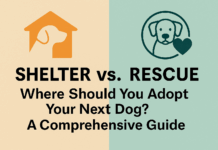Last Updated on August 12, 2022 by Dogs Vets
Thing you need to know after adopting a Rescue Dog
Before you bring your new rescue dog home, there are some things you should consider. These include choosing a good rescue dog, preparing your home, and introducing your new family member to the household.
Using this list can make the transition from shelter to home a breeze.
Make sure to include additional water bowls, especially in gated backyards. Also, get an extra collar with the owner’s information and microchip number on it.
Preparing for a rescue dog
Adopting a rescue dog can be a rewarding experience that helps homeless animals.
Unlike purchasing a dog at a pet store, however, you should prepare for the transition to a new home by learning about the life of an adult dog.
These dogs have unique personalities, and the process of adopting them should be treated with the same level of respect that you would expect from a child.
These tips can help you make the transition easier for both of you.
The first thing you should do to prepare for your new rescue dog is to make your house a safe and comfortable place for it. A dog may be hesitant about the change, and it will take them some time to adjust to a new home.
Having a welcoming home for your rescue dog will ease the transition and help it adjust quickly. Once the dog has settled in, you should consider purchasing toys and other items for the new addition.
Next, check your home for any existing pests. A new dog owner may experience problems due to bugs or rodents, so it is important to check for them before adopting a rescue dog.
If there are any holes or cracks in your home, these can let unwanted visitors in.
During the summer, insects will also get in, so make sure to check windows and doors for leaks and dings.
Once you have chosen a rescue dog, you must prepare your home. Get the new dog a collar, an ID tag, a crate, food, toys, and other necessary items.
Make sure the new dog has all of their shots. If you have cats, make sure they have a separate room for your new pet. This will help the new pup adjust and avoid any accidents.
It’s important to follow the guidelines when adopting a new dog, so you can make the transition as smooth as possible.
Before adopting a new dog, you should take time to walk your home with your new companion.
A dog can be overwhelmed by the amount of changes that they’ve just experienced.
A calm, positive attitude will go a long way in creating a strong relationship with the dog.
The first three days after adoption will be a challenge for you and your new pet, so be prepared to face these challenges. It will be an exciting and rewarding experience!
Choosing a good rescue dog
Adopting a dog from a rescue program is a rewarding experience, but it’s important to be realistic in your expectations.
While choosing a rescue pet is a wonderful way to help save a life, choosing the wrong animal can lead to an unhappy home life and a return to the rescue group.
Listed below are some tips to choosing the right rescue dog for your household. Read these tips before you start looking for a new pet.
Choosing a dog for you depends on your lifestyle and budget. If you have a limited amount of time, an older dog might be perfect for you. This type of dog already has a set personality and physical stature.
The good thing about older dogs is that their housetraining and disposition is already set. This makes them a great choice for those who don’t have much time to devote to dog training.
These dogs may also have been neglected by previous owners and could use some TLC before adoption.
When adopting a rescue dog, be sure to take into account your own lifestyle and circumstances.
Some dogs have temperaments that are more suited to certain households, so make sure that the personality of the dog you want is compatible with yours.
Also, be sure that you leave children at home while you visit the rescue shelter, as kids can easily become attached to a dog. If possible, leave them at home while you are in the shelter and talk to a volunteer about the dog’s personality.
Aside from temperament and age, you should consider the type of environment you’ll be creating for the dog you choose.
For instance, if you’re busy with other people, a highly social dog may be a better choice than a dog with a less active lifestyle.
If you have young children, you’ll want a dog with little energy. An active, energetic breed might be the perfect choice for you and your family.
Choosing a place to bring a rescue dog home
If you are considering adopting a rescue dog, there are several things you should consider. For one, you must be sure that you can take care of the dog’s basic needs.
Rescue dogs can have behavioural problems, so you must be willing to find out about their past history. If the dog is aggressive, you should avoid adopting it. You should also determine who will take care of the dog.
Next, you should prepare the area. Secure the area and fences. Check for gaps or possible escape routes. Decide where the dog will sleep, as well as where it will go outside.
If you have a fenced in yard, you might need to set up a dog crate for the dog’s safety. You should also introduce the dog slowly to other family members, as this will help it get used to the new environment.
Lastly, a good rescue organization will conduct a rigorous screening process. Some will require references from vets, home visits, and an exclusive promise not to adopt the dog if it is not a good match.
The volunteers who foster the dogs at a rescue organization will continue to collect information about the dog, even if you do not adopt it.
You will get to know the dog and its behavior better when you choose a place to bring him home.
Another important factor in bringing a rescue dog home is the temperament.
A dog that is energetic and outgoing will suit an active family while a calm, contented one will be better suited for a person with little or no time for play.
Rescue organizations also have longer histories on the dogs they adopt and may rely on the information provided by the foster home.
However, before bringing a rescue dog home, make sure you have a clear idea of the personality of the dog.
Introducing a rescue dog to your household
Introducing a rescue dog to your household will require some basic house training. The first thing you should do is to take the dog out every day. If your dog does something well, praise it and use treats as rewards.
Dogs thrive on a routine and will settle in better if there is a set schedule for them. This is particularly important for rescue dogs, as they have been neglected for long periods of time. You should make the new dog meet the resident dog at a neutral place before bringing it home.
Introduce the two dogs slowly to avoid fear-based or aggressive reactions. Once these bad behaviors have been reinforced, they are difficult to change.
You should introduce each dog one at a time. This will help both dogs adjust quickly and make the transition easier. Make sure to supervise both dogs during the first few days.
You can also introduce a new dog to the household when you have other dogs.
While the first three days are important for adjusting to the new environment, the adjustment period will take longer for some dogs. Others will adjust more quickly. Whatever the case, make the transition as easy as possible.
Remember that a rescue dog will be rebellious when settling in, as this is a way of testing the boundaries. Make sure to stick to the rules to keep your new friend happy. If you fail to adhere to the rules, your new pet will lose trust in you.
The new dog should meet the residents first, and then introduce himself to the dogs. You should separate the new dog from the older dog. Make sure the new dog shows positive body language, such as a playful, friendly face.
The first few meetings should be brief and separate the two. Then, move on to the next step. If your new dog is hesitant, introduce the two dogs on a walk.
During this time, the new dog will be confused and may forget some of the things he knows. Therefore, make sure to provide plenty of water and a comfortable place to lie down.
Make sure to separate the two dogs using leashes, so that the resident dog is not intimidated.
You should also remove toys that your previous dog may have used as weapons during the initial period. Depending on the breed of each dog, the introduction period may take several weeks.
Fact Check
We hope you enjoyed this article… What are your thoughts?
Pls feel free to share this article!

















